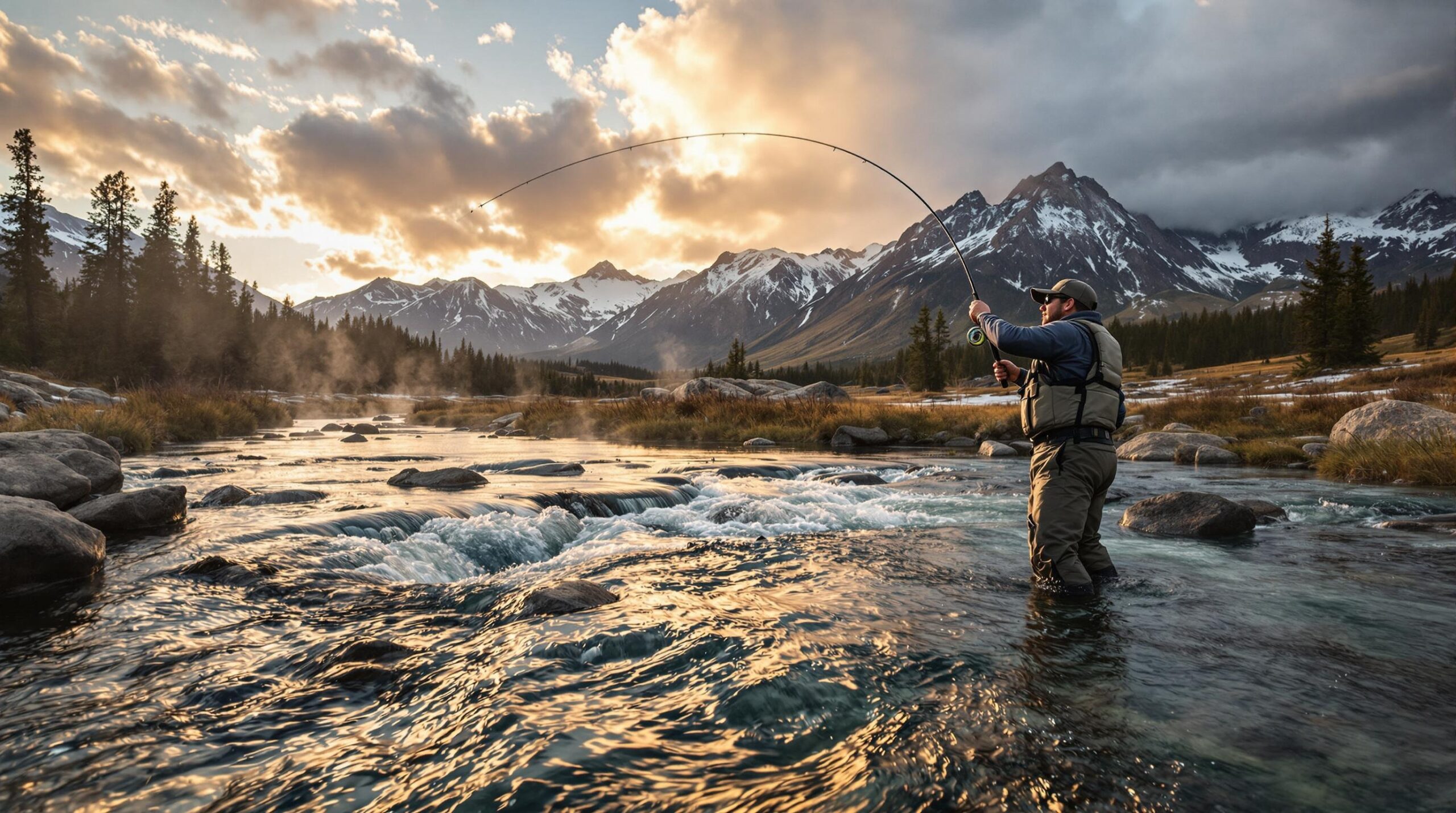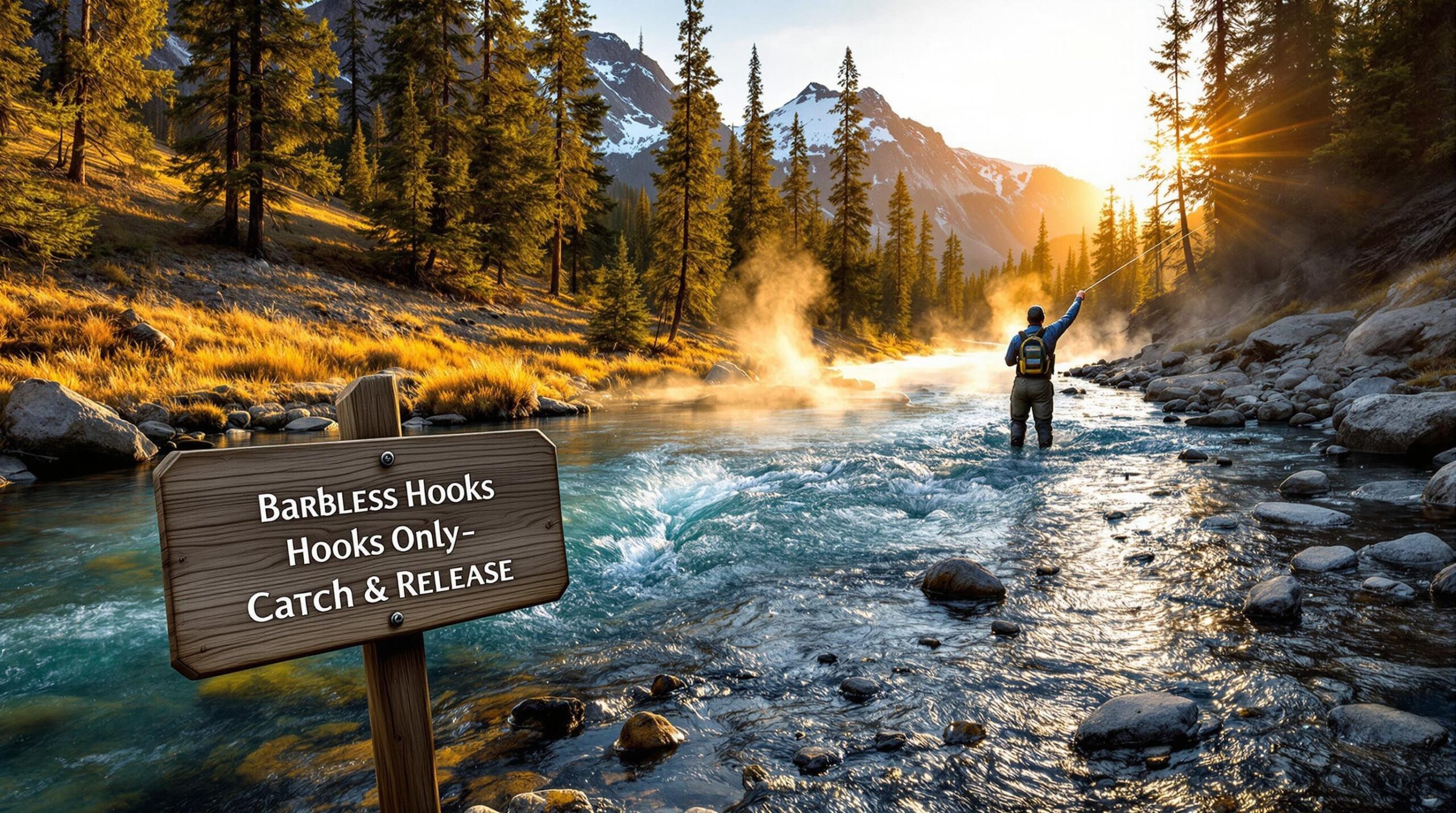Yellowstone National Park stands as America’s most strictly regulated fly fishing destination, with the National Park Service enforcing more than 30 specific regulations to protect its pristine ecosystem. These conservation policies allow anglers to experience world-class fishing in waters that remain as untouched as when the park was established in 1872.
Key Takeaways
- Yellowstone requires a special fishing permit separate from state licenses for all anglers over 16
- Barbless hooks are mandatory park-wide to reduce fish mortality rates
- Catch and release is required on most waters, with only a few lakes allowing limited harvest
- Lead fishing tackle is prohibited throughout the park to prevent wildlife poisoning
- Specific seasonal closures protect spawning fish during critical reproduction periods
Essential Permit Requirements for Yellowstone Fly Fishing Travel Destinations
Yellowstone’s permit system operates independently from Wyoming and Montana state fishing licenses. All anglers 16 and older must purchase a Yellowstone Conservation Stamp, which costs $18 for a three-day permit, $25 for seven days, or $40 for the entire season.
Children aged 12-15 can fish with a complimentary permit, while kids under 12 fish free when supervised by a licensed adult. The permits fund critical habitat restoration projects and fisheries research throughout the park’s 2.2 million acres.
Yellowstone fly fishing permits are available at all visitor centers, ranger stations, and Yellowstone General Stores. Online purchases aren’t available, so plan to buy permits upon arrival.
Tackle Restrictions That Protect Yellowstone’s Ecosystem
The park’s tackle regulations reflect decades of scientific research on fish welfare and environmental protection. Barbless hooks became mandatory in 1973 after studies showed they reduced fish mortality by up to 40% compared to barbed alternatives.
Lead tackle prohibition extends beyond fishing weights to include any lead components in flies or lures. The U.S. Geological Survey documented lead poisoning in trumpeter swans and other waterfowl that ingested lost fishing tackle, prompting this complete ban.
Fly patterns must use non-toxic materials exclusively. Popular alternatives include tungsten beads, brass weights, and copper wire wrapping. Many fly shops near park entrances stock Yellowstone-compliant patterns specifically designed for the park’s waters.
Approved Tackle Materials for Fly Fishing Travel Destinations
These materials meet Yellowstone’s environmental standards:
- Tungsten beads and weights
- Brass components
- Copper wire and tubing
- Steel hooks (barbless only)
- Natural and synthetic fly-tying materials without lead content
Water-Specific Regulations Across Yellowstone’s Fly Fishing Travel Destinations
Yellowstone’s 12 major rivers and 290 lakes each operate under specific regulations tailored to protect unique ecosystems. The Yellowstone River above Yellowstone Falls requires catch and release for all species, while Shoshone Lake permits limited cutthroat trout harvest during specific seasons.
Lewis Lake allows harvest of lake trout to protect native cutthroat populations, as lake trout compete aggressively for the same habitat. The park’s native fish restoration program has removed over 3.8 million lake trout from Yellowstone Lake since 1994.
Fishing from thermal features or their immediate runoff areas is strictly prohibited. These regulations protect both angler safety and fragile geothermal ecosystems that support unique microbial communities.
Major Water Bodies and Their Specific Rules
Understanding individual water regulations helps anglers plan successful trips to these fly fishing travel destinations:
| Water Body | Season | Regulations |
|---|---|---|
| Yellowstone River (above falls) | July 15 – Nov 6 | Catch and release only |
| Madison River | Last Sat May – Nov 6 | Catch and release only |
| Gibbon River | Last Sat May – Nov 6 | Catch and release only |
| Lewis Lake | June 15 – Oct 31 | Lake trout harvest encouraged |
| Shoshone Lake | July 15 – Sept 30 | Limited cutthroat harvest |
Seasonal Closures That Protect Spawning Fish
Spring closures protect cutthroat trout during their spawning runs from Yellowstone Lake into tributary streams. These fish travel up to 40 miles to reach spawning grounds, making them vulnerable during migration periods.
The Yellowstone River below Yellowstone Lake closes from April 1 to July 15, when thousands of cutthroat concentrate in shallow spawning areas. Similar closures protect spawning mountain whitefish during autumn months.
Yellowstone fishing seasons typically run from late May through early November, with specific dates varying by elevation and water temperature. High-elevation lakes may not become fishable until late June due to ice coverage.
The Science Behind Yellowstone’s Conservation Policies
Yellowstone’s fishing regulations stem from ecological research spanning over five decades. The park’s fisheries program represents one of the longest-running aquatic ecosystem studies in North America, providing data about native species recovery and habitat protection.
Native Yellowstone cutthroat trout populations declined by over 90% between 1980 and 2010 due to lake trout predation and habitat degradation. The park’s aggressive conservation measures, including angling restrictions and invasive species removal, have stabilized populations in recent years.
Research conducted by the U.S. Geological Survey’s Northern Rocky Mountain Science Center shows that barbless hook regulations reduce handling stress in cutthroat trout by 35%, while mandatory catch and release maintains breeding populations at sustainable levels.
Native Species Recovery Success Stories
Yellowstone’s conservation approach has produced measurable results across multiple species and habitats. The park’s monitoring program tracks fish populations annually, providing data that informs regulation adjustments.
Arctic grayling populations in the Gibbon River have increased by 200% since 2000, largely due to habitat restoration and strict catch-and-release policies. These native fish, once widespread throughout the Greater Yellowstone Ecosystem, now survive in only a handful of waters.
Westslope cutthroat trout populations in the park’s western drainages have stabilized after decades of decline. Genetic analysis reveals that Yellowstone harbors some of the purest native trout strains remaining in the lower 48 states.
Understanding Yellowstone’s Ecosystem Approach to Fly Fishing Travel Destinations
Yellowstone’s fishing regulations reflect a holistic ecosystem management philosophy that considers the interconnectedness of aquatic and terrestrial environments. Fish populations support wildlife from grizzly bears catching spawning trout to osprey diving for cutthroat in shallow bays.
The park’s thermal features create unique aquatic environments found nowhere else on Earth. Waters heated by geothermal activity support specialized bacterial communities that form the base of complex food webs. These ecosystems require protection from fishing pressure and habitat disturbance.
Climate change adds new challenges to fish conservation in Yellowstone. Rising water temperatures stress cold-water species like cutthroat trout, while changing precipitation patterns affect spawning success. The park’s adaptive management approach allows for regulation changes based on environmental monitoring data.
Wildlife Dependencies on Healthy Fish Populations
Yellowstone’s fishing regulations protect not just fish, but entire ecosystem webs that depend on healthy aquatic communities. Grizzly bears rely on spawning cutthroat trout for up to 30% of their annual caloric intake during peak runs in tributary streams.
Osprey populations directly correlate with fish abundance in the park’s major lakes and rivers. The Yellowstone Bird Program documents that osprey nesting success rates increase significantly during years with strong cutthroat populations.
River otters, great blue herons, and belted kingfishers all depend on fish communities for survival. Maintaining sustainable fish populations through careful regulation allows these species to continue thriving in Yellowstone’s pristine environment.
Enforcement and Compliance in Yellowstone’s Fly Fishing Travel Destinations
Park rangers actively patrol popular fishing areas, checking permits and tackle compliance. Violations carry substantial penalties, including fines up to $5,000 and potential criminal charges for serious infractions. The park’s zero-tolerance approach to regulation violations protects both resources and maintains angling opportunities for future generations.
Rangers receive specialized training in fishing regulations and enforcement techniques. Many rangers are experienced anglers themselves, understanding both the technical aspects of fishing and the ecological importance of conservation measures.
Visitor education plays a vital role in compliance success. The park’s fishing regulations brochure, available in multiple languages, explains not just the rules but the scientific reasoning behind each restriction. This educational approach has reduced violation rates by over 40% since 2010.
Common Violations and Their Consequences
Understanding common infractions helps anglers avoid unintentional violations while fishing these premier fly fishing travel destinations. The most frequent citations involve improper permits, lead tackle use, and harvest violations in catch-and-release waters.
Using barbed hooks results in mandatory court appearances and fines starting at $150. Lead tackle violations carry similar penalties, plus mandatory tackle confiscation. These strict penalties reflect the serious environmental consequences of regulation violations.
Fishing without proper permits accounts for nearly 60% of citations issued in Yellowstone. Rangers check permits frequently, especially during peak fishing seasons. Claiming ignorance of permit requirements doesn’t exempt anglers from penalties.
Planning Your Visit to Yellowstone’s Fly Fishing Travel Destinations
Successful Yellowstone fishing trips require advance planning that accounts for the park’s unique regulations and seasonal patterns. The best fishing typically occurs during late summer and early fall, when water temperatures moderate and insect hatches peak.
Weather conditions can change rapidly in Yellowstone’s high-elevation environment. Anglers should prepare for temperature swings of 40 degrees or more within a single day. Hypothermia risks exist even during summer months, particularly when wading in snowmelt-fed streams.
Park entrance fees are separate from fishing permits and cost $35 per vehicle for seven days or $70 for an annual pass. America the Beautiful passes provide free park entry but don’t cover fishing permits. Budget approximately $100 per person for permits and entrance fees during a week-long fishing trip.
Essential Gear for Regulation Compliance
Packing regulation-compliant gear guarantees uninterrupted fishing in Yellowstone’s world-class waters. Most sporting goods stores near park entrances carry approved tackle, but prices typically run 20-30% higher than outside the park.
A complete Yellowstone-compliant tackle box should include tungsten-weighted flies, barbless hooks in various sizes, and lead-free split shot. Pliers for pinching down barbs on existing flies are essential, as many commercial patterns come with barbed hooks.
Consider bringing a small digital scale and measuring device for the few waters that allow harvest. Accurate measurement prevents accidental violations in size-restricted waters. Photography equipment helps document catches for the memories without requiring fish harvest.
Future of Conservation in Yellowstone’s Fly Fishing Travel Destinations
Yellowstone’s fishing regulations continue evolving based on ongoing research and environmental changes. Climate change projections suggest that high-elevation waters may become increasingly important as lower-elevation streams warm beyond optimal temperatures for native species.
The park’s scientists are developing new monitoring techniques using environmental DNA sampling to track fish populations more accurately. This technology allows researchers to detect species presence without traditional netting or electrofishing methods that can stress fish populations.
Native species restoration efforts are expanding beyond the current focus on cutthroat and grayling recovery. Plans include potential reintroduction of river otters in areas where they’ve been absent for decades, creating more complete aquatic ecosystems.
Partnerships with universities and conservation organizations provide additional research capacity for Yellowstone’s fisheries program. The Yellowstone Forever foundation funds critical research projects that inform management decisions and regulation updates.
FAQ
Do I need a Wyoming or Montana fishing license to fish in Yellowstone?
No, you only need a Yellowstone Conservation Stamp to fish within park boundaries. State licenses aren’t required, but you’ll need appropriate state permits if fishing outside the park.
Can I use flies with barbed hooks if I pinch down the barbs?
Yes, pinching down barbs on existing flies is acceptable and commonly practiced. Many anglers carry small pliers specifically for this purpose when fishing Yellowstone’s waters.
What happens if I accidentally catch and keep a fish in catch-and-release waters?
You must immediately release the fish if it’s still alive. If the fish dies, report it to the nearest ranger station. Penalties apply only to intentional violations or gross negligence.
Are there any waters in Yellowstone where I can keep fish?
Yes, a few lakes allow limited harvest including Lewis Lake for lake trout and Shoshone Lake for cutthroat during specific seasons. Check current regulations for details and limits.
Can I fish from bridges or thermal features in the park?
Bridge fishing is allowed where safe and legal, but thermal features and their immediate runoff areas are strictly off-limits. These areas are clearly marked with warning signs.
What’s the penalty for fishing without a Yellowstone permit?
Fines start at $150 for first-time violations and can increase to $5,000 for repeat offenses. Court appearances are mandatory for most fishing violations in federal court.
Ready to experience Yellowstone’s world-class fly fishing? Start planning your trip by reviewing the current regulations and securing your permits. The park’s pristine waters await responsible anglers who respect these time-tested conservation practices.
Sources:
National Park Service
National Park Service
United States Geological Survey
Trout Unlimited
Montana State University
Climate.gov
American Fisheries Society
University of Wyoming
Flathead Lake Biological Station
Greater Yellowstone Coalition


